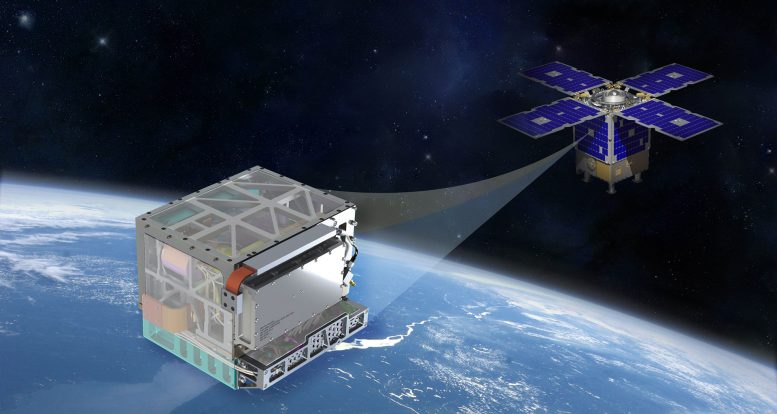
A glimpse of the Deep Space Atomic Clock in the middle bay of the General Atomics Orbital Test Bed spacecraft. Credit: NASA
In deep space, accurate timekeeping is vital to navigation, but not all spacecraft have precise timepieces aboard. For 20 years, NASA’s Jet Propulsion Laboratory (JPL) in Pasadena, California, has been perfecting a clock. It’s not a wristwatch; not something available in a store. It’s the Deep Space Atomic Clock (DSAC), an instrument being built for deep space exploration.
Currently, most missions rely on ground-based antennas paired with atomic clocks for navigation. Ground antennas send narrowly focused signals to spacecraft, which, in turn, return the signal. NASA uses the difference in time between sending a signal and receiving a response to calculate the spacecraft’s location, velocity and path.
This method, though reliable, could be made much more efficient. For example, a ground station must wait for the spacecraft to return a signal, so a station can only track one spacecraft at a time. This requires spacecraft to wait for navigation commands from Earth rather than making those decisions onboard and in real-time.
“Navigating in deep space requires measuring vast distances using our knowledge of how radio signals propagate in space,” said Todd Ely of JPL, DSAC’s principal investigator. “Navigating routinely requires distance measurements accurate to a meter or better. Since radio signals travel at the speed of light, that means we need to measure their time-of-flight to a precision of a few nanoseconds. Atomic clocks have done this routinely on the ground for decades. Doing this in space is what DSAC is all about.”
The DSAC project aims to provide accurate onboard timekeeping for future NASA missions. Spacecraft using this new technology would no longer have to rely on two-way tracking. A spacecraft could use a signal sent from Earth to calculate position without returning the signal and waiting for commands from the ground, a process that can take hours. Timely location data and onboard control allows for more efficient operations, more precise maneuvering and adjustments to unexpected situations.
This paradigm shift enables spacecraft to focus on mission objectives rather than adjusting their position to point antennas earthward to close a link for two-way tracking.
Additionally, this innovation would allow ground stations to track multiple satellites at once near areas like Mars, crowded with NASA science missions. In certain scenarios, the accuracy of that tracking data would exceed traditional methods by a factor of five.
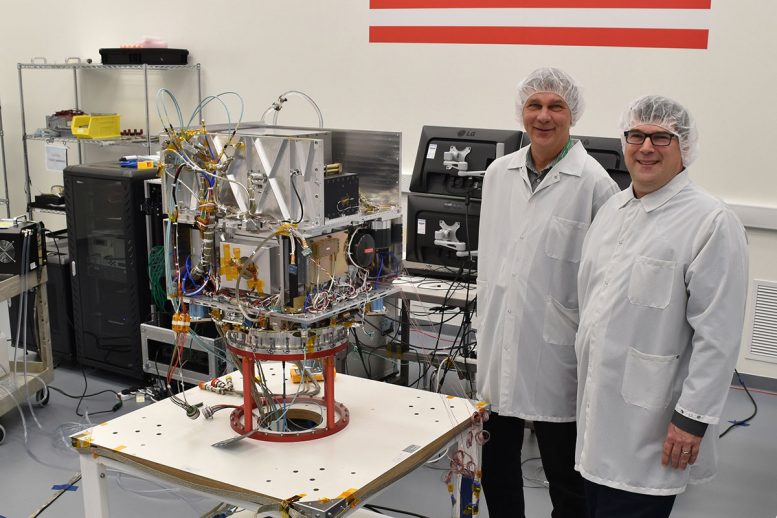
Tom Cwik, the head of JPL’s Space Technology Program (left) and Allen Farrington, JPL Deep Space Atomic Clock Project Manager, view the integrated Atomic Clock Payload on Surrey Satellite US’s Orbital Test Bed Spacecraft. Credit: Surrey Satellite Technology.
DSAC is an advanced prototype of a small, low-mass atomic clock based on mercury-ion trap technology. The atomic clocks at ground stations in the Deep Space Network are about the size of a refrigerator. DSAC is about the size of a four-slice toaster, and could be further miniaturized for future missions.
The DSAC test flight will take this technology from the laboratory to the space environment. While in orbit, the DSAC mission will use the navigation signals from U.S. GPS coupled with precise knowledge of GPS satellite orbits and clocks to confirm DSAC’s performance. The demonstration should confirm that DSAC can maintain time accuracy to better than two nanoseconds (.000000002 seconds) over a day, with a goal of achieving 0.3 nanosecond accuracy.
Once DSAC has proven the technology, future missions can use its technology enhancements. The clock promises increased tracking data quantity and improved tracking data quality. Coupling DSAC with onboard radio navigation could ensure that future exploration missions have the navigation data needed to send humans back to the moon and traverse the solar system.
Technologies aboard DSAC could also improve GPS clock stability and, in turn, the service GPS provides to users worldwide. Ground-based test results have shown DSAC to be upwards of 50 times more stable than the atomic clocks currently flown on GPS. DSAC promises to be the most stable navigation space clock ever flown.
“We have lofty goals for improving deep space navigation and science using DSAC,” said Ely. “It could have a real and immediate impact for everyone here on Earth if it’s used to ensure the availability and continued performance of the GPS system.”
DSAC is a partnership between NASA’s Space Technology Mission Directorate and the Space Communications and Navigation program office, a program under the Human Exploration and Operations Mission Directorate. DSAC will launch in 2018 as a hosted payload on General Atomic’s Orbital Test Bed spacecraft aboard the U.S. Air Force Space Technology Program (STP-2) mission.
For more information about DSAC visit nasa.gov/mission_pages/tdm/clock.

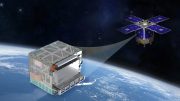
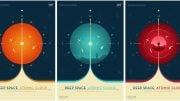


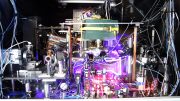


Be the first to comment on "NASA Researchers Test Deep Space Atomic Clock (DSAC)"